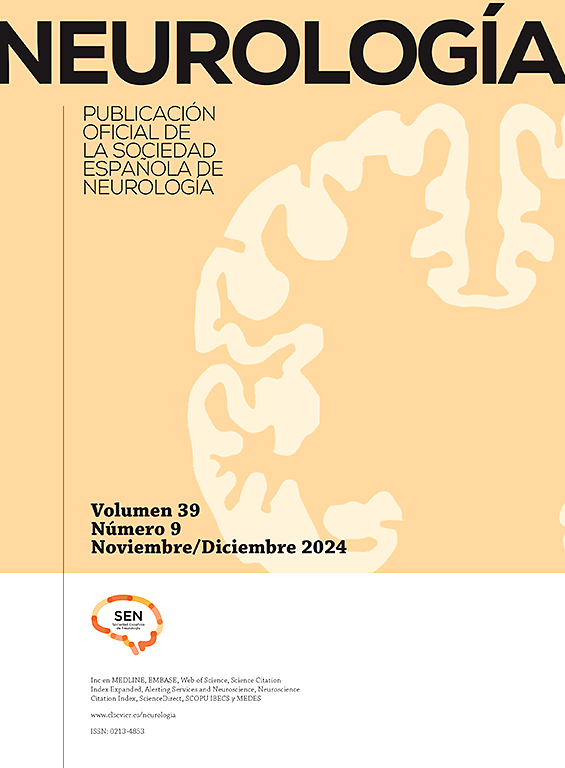丙戊酸盐/锂盐联合治疗ALS患者的2期、双盲、安慰剂对照试验
IF 3.1
4区 医学
Q2 CLINICAL NEUROLOGY
引用次数: 0
摘要
背景:目前针对肌萎缩性侧索硬化症(ALS)的治疗方法很少。碳酸锂和丙戊酸(VPA-Li)的组合被证明可以抑制运动神经元死亡并延缓疾病进展。方法采用随机、安慰剂对照的方法,对具有典型ALS临床表现的门诊患者进行研究,评估口服VPA-Li的疗效。功能量表评分(ALSFRS-R)和生存率的变化被选为主要结局变量。次要结果变量包括BMI、呼吸监测、生活质量和对治疗的总体印象。结果在纳入的42名患者中,20名接受VPA-Li治疗的患者和18名接受安慰剂治疗的患者被纳入最终分析。接受VPA-Li治疗的患者中有45%完成了试验,而安慰剂组只有22.22%的患者在18个月后参加了最后一次就诊(P = 0.09)。观察到ALSFRS-R评分的主要变化,包括在第6至14个月期间,安慰剂组下降1.195分/月(95% CI: 0.7869-1.6031), VPA-Li治疗组下降0.5085分/月(95% CI: 0.2288-0.7882)。不良反应包括口腔异味、便秘和厌食症。在试验结束时,存活率、体重和生活质量都是积极的结果,尽管样本减少了很多,特别是在安慰剂组。每组纳入212名受试者将证实这些差异。结论VPA-Li联合治疗可减缓ALS的进展,改善次要预后。这种双重治疗克服了无效阈值,值得在ALS中进一步研究。本文章由计算机程序翻译,如有差异,请以英文原文为准。
A phase 2, double-blind, placebo-controlled trial of a valproate/lithium combination in ALS patients
Background
Few treatments are currently available for amyotrophic lateral sclerosis (ALS). A combination of lithium carbonate and valproic acid (VPA-Li) was shown to inhibit motor neuron death and delay disease progression.
Methods
Outpatients with a typical ALS presentation were enrolled in a randomized, placebo-controlled trial to assess the efficacy of orally administered VPA-Li. Changes in a functional scale score (ALSFRS-R) and survival rate were chosen as primary outcome variables. Secondary outcome variables included BMI, respiratory monitoring, quality of life, and a global impression of the treatment.
Results
Out of 42 patients enrolled, 20 individuals receiving VPA-Li and 18 on placebo treatment were included in the final analysis. Forty-five percent of patients receiving VPA-Li completed the trial, whereas only 22.22% of patients in the placebo group attended the final visit 18 months later (P = 0.09). Major changes in the ALSFRS-R score were observed, including a decrease of 1.195 points/month in the placebo group (95% CI: 0.7869–1.6031) and of 0.5085 under VPA-Li treatment (95% CI: 0.2288–0.7882) between months 6 and 14. Adverse events included bad mouth taste, constipation, and anorexia. Survival rate, body weight, and quality of life were positive outcomes by the end of the trial despite a high sample reduction, especially in the placebo group. The inclusion of 212 subjects in each group would confirm these differences.
Conclusions
Combined VPA-Li treatment associated with slower ALS progression and better secondary outcomes. This dual treatment overcame the futility threshold and merits further investigation in ALS.
求助全文
通过发布文献求助,成功后即可免费获取论文全文。
去求助
来源期刊

Neurologia
医学-临床神经学
CiteScore
5.90
自引率
2.60%
发文量
135
审稿时长
48 days
期刊介绍:
Neurología es la revista oficial de la Sociedad Española de Neurología y publica, desde 1986 contribuciones científicas en el campo de la neurología clínica y experimental. Los contenidos de Neurología abarcan desde la neuroepidemiología, la clínica neurológica, la gestión y asistencia neurológica y la terapéutica, a la investigación básica en neurociencias aplicada a la neurología. Las áreas temáticas de la revistas incluyen la neurologia infantil, la neuropsicología, la neurorehabilitación y la neurogeriatría. Los artículos publicados en Neurología siguen un proceso de revisión por doble ciego a fin de que los trabajos sean seleccionados atendiendo a su calidad, originalidad e interés y así estén sometidos a un proceso de mejora. El formato de artículos incluye Editoriales, Originales, Revisiones y Cartas al Editor, Neurología es el vehículo de información científica de reconocida calidad en profesionales interesados en la neurología que utilizan el español, como demuestra su inclusión en los más prestigiosos y selectivos índices bibliográficos del mundo.
 求助内容:
求助内容: 应助结果提醒方式:
应助结果提醒方式:


